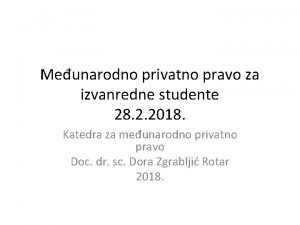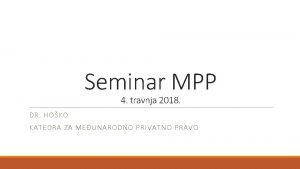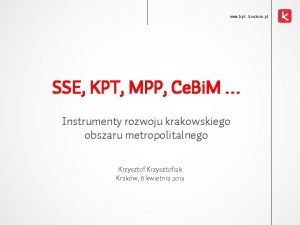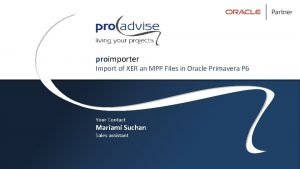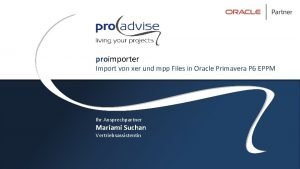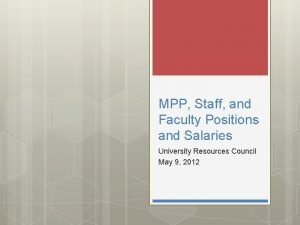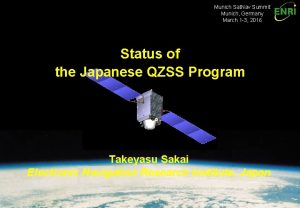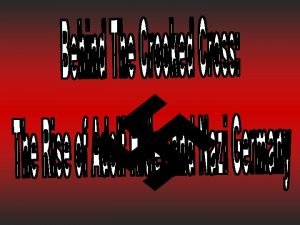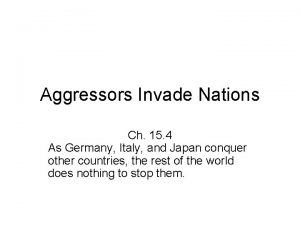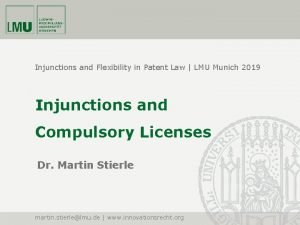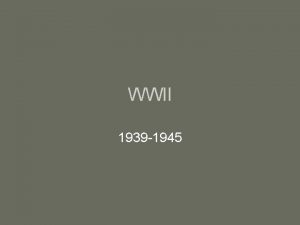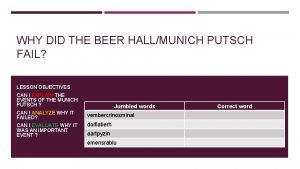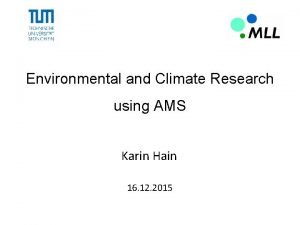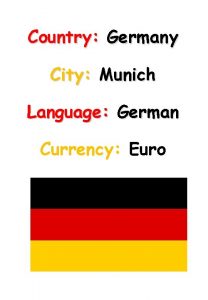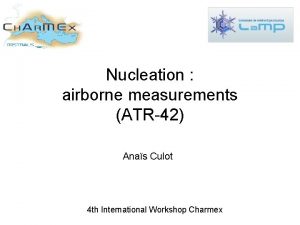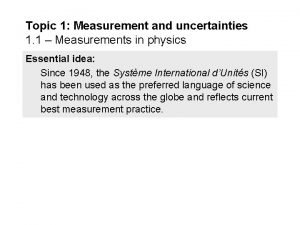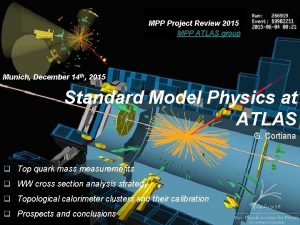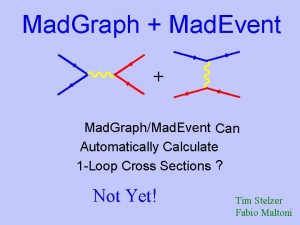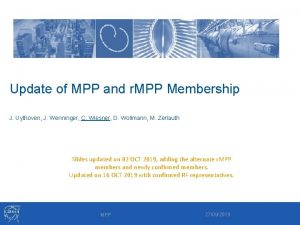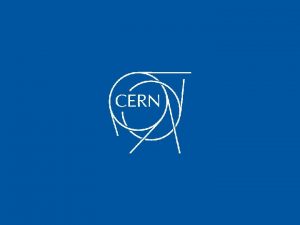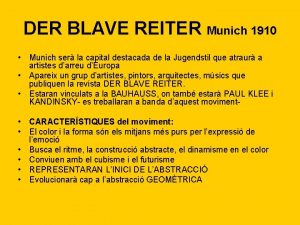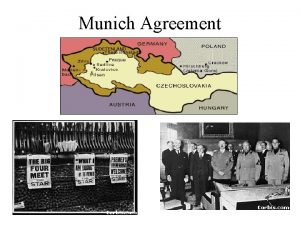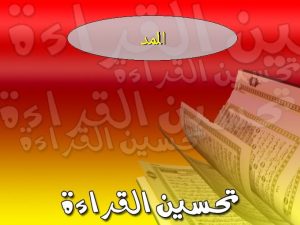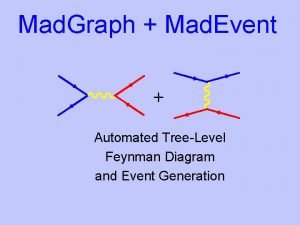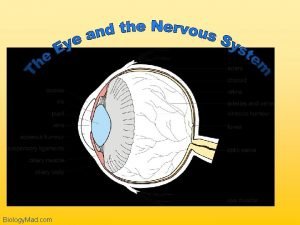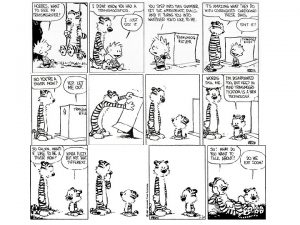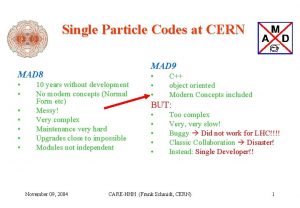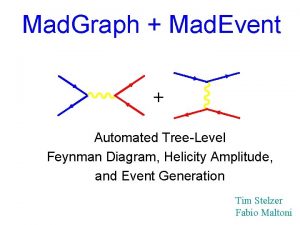DetectorReceiver Cold Measurements Mad MaxWorkshop MPP Munich O




































- Slides: 36

Detector/Receiver “Cold” Measurements Mad. Max-Workshop MPP Munich O. Reimann for the MADMAX-Group May 10, 2017

Outline • Microwave radiometer (short reminder) ▫ Comparison between photon- and heterodyne detection • Current lab system ▫ Schematic ▫ First cold tests • Conclusion Slide 2 Mad. Max-Workshop Nov. 21/22 2016 O. Reimann / MPP

Photon Detection Setups • Two principle ways: ▫ Photon counting ▫ Measurement of mean photon flux • Photon counting ▫ Limited by photon energy (Needs „high energy“ photons) ▫ Energy (frequency) resolution is limited • Photon flux measurement ▫ Not limited by low energy photons ▫ Excellent frequency (energy) resolution (easily it can be better than 10 -9), because of usually used “coherent” detection (normally heterodyne detection) Slide 3 Mad. Max-Workshop Nov. 21/22 2016 O. Reimann / MPP

Photon Detection Setups • Photon counting: Detector Counter • Photon flux measurement: direct Detector heterodyne (“coherent”) Current meter Mixer Bandpass Detector Current meter Oscillator Slide 4 Mad. Max-Workshop Nov. 21/22 2016 O. Reimann / MPP

Choosing the Right Bandwidth • What is the detectable noise temperature for a given system noise temperature (Dicke-formula): Df. F: Filter bandwidth t: Averaging time TSys: Total system noise temp. • Detectable noise power (assuming no gain fluctuation) with and • Averaging time for a given signal/noise ratio: with Slide 5 Mad. Max-Workshop Nov. 21/22 2016 O. Reimann / MPP

Choosing the Right Bandwidth • What is the best bandwidth for line detection ▫ Detectable background noise power increases with frequency (Square root) ▫ Signal noise increases with frequency (Linear, if rect. distribution) ▫ → Bandwidth should not be larger than linewidth for best signalnoise ratio Example Receiver: TSys=5 K Signal: 10 -23 W (1 photon/s @ 15 GHz), linewidth 10 k. Hz, equal distributed Slide 6 Mad. Max-Workshop Nov. 21/22 2016 O. Reimann / MPP

Receiver • Axion mass range: 40 µe. V … 400 µe. V Frequency range: 10 GHz … 100 GHz (l = 3 cm … 3 mm) • Detection of signal line in frequency domain with Dn. A = 10 -6 n. A • … Slide 7 Mad. Max-Workshop Nov. 21/22 2016 O. Reimann / MPP

Low-Noise Amplifiers • 2 different devices (Low Noise Factory, Chalmer University) • Same characteristics @ RT but 1 is for cryo temperatures cannot significantly reduced (Nature Materials Nov. 10, 2014 6 -20 GHz Cryogenic Low Noise Amplifier, 5 K @ 8 -10 K 1 -15 GHz Low Noise Amplifier, 75 K @ RT © Low Noise Factory Slide 8 Mad. Max-Workshop Nov. 21/22 2016 O. Reimann / MPP

Heterodyne Detection Her the reality is a little bit more complicated! (FT-analysis) • Lab system: Signal analyzer (4 samplers, 1. 4% dead time) Front end mixers and amps Fake axion LHe bath → 4 K THe + 5. 5 K TAmp = 9. 5 K TSys Slide 9 Mad. Max-Workshop Nov. 21/22 2016 O. Reimann / MPP

Heterodyne Detection: First Cold Test • Inject fake axion signal with 1. 2. 10 -22 W at LHe temp. ▫ Frequency: 18. 85 GHz ▫ Frequency modulated with gaussian noise ▫ Signal bandwidth: 8 k. Hz, Lorentz-shaped Slide 10 Mad. Max-Workshop Nov. 21/22 2016 O. Reimann / MPP

Heterodyne Detection: First Cold Test • Inject fake axion signal with 1. 2. 10 -22 W at LHe temp. ▫ Frequency: 18. 85 GHz ▫ Frequency modulated with gaussian noise ▫ Signal bandwidth: 8 k. Hz, Lorentz-shaped ▫ Received signal after 28 h measurement (averaged signal): Slide 11 Mad. Max-Workshop Nov. 21/22 2016 O. Reimann / MPP

Heterodyne Detection: First Cold Test • Inject fake axion signal with 1. 2. 10 -22 W at LHe temp. ▫ Frequency: 18. 85 GHz ▫ Frequency modulated with gaussian noise ▫ Signal bandwidth: 8 k. Hz, Lorentz-shaped ▫ Received signal after baseline subtraction and gain correction: Slide 12 Mad. Max-Workshop Nov. 21/22 2016 O. Reimann / MPP

Heterodyne Detection: First Cold Test • Inject fake axion signal with 1. 2. 10 -22 W at LHe temp. ▫ Frequency: 18. 85 GHz ▫ Frequency modulated with gaussian noise ▫ Signal bandwidth: 8 k. Hz, Lorentz-shaped Highest peak ▫ X-Correlation signal with 8 k. Hz width: s: Signal T: Testfunction (Lorentz, Gauss, …) Slide 13 Mad. Max-Workshop Nov. 21/22 2016 O. Reimann / MPP

Heterodyne Detection: First Cold Test • Inject fake axion signal with 1. 2. 10 -22 W at LHe temp. ▫ Frequency: 18. 85 GHz ▫ Frequency modulated with gaussian noise ▫ Signal bandwidth: 8 k. Hz, Lorentz-shaped ▫ X-Correlation signal with 8 k. Hz width (Zoom): Slide 14 Mad. Max-Workshop Nov. 21/22 2016 O. Reimann / MPP

Heterodyne Detection: First Cold Test • Inject fake axion signal with 1. 2. 10 -22 W at LHe temp. ▫ Frequency: 18. 85 GHz ▫ Frequency modulated with gaussian noise ▫ Signal bandwidth: 8 k. Hz, Lorentz-shaped ▫ Why 8 k. Hz Bandwidth? Algorithm is searching for best S/N-ratio: Slide 15 Mad. Max-Workshop Nov. 21/22 2016 O. Reimann / MPP

Heterodyne Detection: First Cold Test • Inject fake axion signal with 1. 2. 10 -22 W at LHe temp. ▫ Frequency: 18. 85 GHz ▫ Frequency modulated with gaussian noise ▫ Signal bandwidth: 8 k. Hz, Lorentz-shaped ▫ Why 8 k. Hz Bandwidth? Algorithm is searching for best S/N-ratio: Bin # Slide 16 Peak Freq. in Hz Best Filter in Hz X-corr. S/N Mad. Max-Workshop Nov. 21/22 2016 Signal # O. Reimann / MPP

Heterodyne Detection: First Cold Test • Inject fake axion signal with 1. 2. 10 -22 W at LHe temp. ▫ Frequency: 18. 85 GHz ▫ Frequency modulated with gaussian noise ▫ Signal bandwidth: 8 k. Hz, Lorentz-shaped ▫ Signal + Lorentz-fit (8 k. Hz): Slide 17 Mad. Max-Workshop Nov. 21/22 2016 O. Reimann / MPP

Additional Facts: • Comparison with Allen’s run statistic algorithm showed good agreement • Cold tests are ongoing ▫ 5. 10 -23 W in 10 k. Hz linewidth already reached within one week in 10 K Tsys (Physical limit) ▫ Different tests runs should give a clearer insight to possible problems (quantization noise, …) Slide 18 Mad. Max-Workshop Nov. 21/22 2016 O. Reimann / MPP

Conclusion • Receiver concept is OK ▫ Dead time 1, 4% ▫ Sensitivity in warm and cold is OK • Next Tests: ▫ Systematic cold measurements ▫ Better Antenna measurements ▫ Cold background measurements in cryostat Slide 19 Mad. Max-Workshop Nov. 21/22 2016 O. Reimann / MPP

Appendix Slide 20 Mad. Max-Workshop Nov. 21/22 2016 O. Reimann / MPP

Spectral Power Density of (BB)-Noise • Contribution of a detector: (no phase preservation) • Contribution of an amplifier or mixer: (phase preservation) • Limit for low frequencies and/or high temperatures: Slide 21 Noise temperature Mad. Max-Workshop Nov. 21/22 2016 O. Reimann / MPP

Spectral Power Density of (BB)-Noise • Example: ▫ Spectral power density for different temperatures Amplifier, Mixer EN(W Hz-1) 400 K 10 K Detector 100 K 1 K “Quantum limit” Frequency (Hz) Slide 22 Mad. Max-Workshop Nov. 21/22 2016 O. Reimann / MPP

Noise Equivalent Power • System noise temperature TSys and bandwidth Df. F are difficult to measure for broadband detectors ▫ ▫ ▫ Johnson noise Phonon-electron coupling Generation-recombination noise Background noise … • → Using noise equivalent power (NEP): • Sometimes a little bit different NEP definitions are used, most of them have factor 2½ included (Because of 2 polarizations or time to bandwidth conversion) Slide 23 Mad. Max-Workshop Nov. 21/22 2016 O. Reimann / MPP

Broadband detectors • Types of broadband detectors ▫ ▫ Bolometers Microwave kinetic inductance detector (MKID) Double quantum well detectors Transition edge sensors (TES) • Usually they work good only at higher frequencies (> 50 … 100 GHz) • Often the devices are background limited ▫ Example: Background temperature 300 K, bandwidth 50 GHz → NEP = 9. 2 10 -16 W Hz-½ • Temperature and bandwidth can be reduced, but then again the other noise sources start to dominate (see later)! Slide 24 Mad. Max-Workshop Nov. 21/22 2016 O. Reimann / MPP

Comparison: Heterodyne Direct Det. NEP (W Hz-½) • Noise equivalent power of a heterodyne system: State-of-the-art bolometer Non-existing graphene bolometer with 10 MHz coupling bandwidth and 20 m. K temperature [1]. Unrealistic!!! Frequency (Hz) [1] K. C. Fong and K. C. Schwab, “Ultra-sensitive and Wide Bandwidth Thermal Measurements of Graphene at Low Temperatures“, 2012 Slide 25 Mad. Max-Workshop Nov. 21/22 2016 O. Reimann / MPP

Heterodyne Detection: Real Devices • Noise temperature limit for In. P devices: ▫ Mainly phonon self heating Inner bulk black body radiator In. P-HFET, Bryerton et. al. “Ultra Low Noise Cryogenic Amplifiers for Radio Astronomy”, 2013 Shi, et. al. A 100 -GHz Fixed-Tuned Waveguide SIS Mixer Exhibiting Broad Bandwidth and Very Low Noise Temperature, 1997 In. P-HEMT Our amplifier, LNF Slide 26 Mad. Max-Workshop Nov. 21/22 2016 O. Reimann / MPP

First Cold Measurement • First quick and dirty test: ▫ Very simple test in LHe-dewar ▫ Amplifier at LHe-temperature (4. 1 K) Gain Noise temperature Room for improvement! Slide 27 Mad. Max-Workshop Nov. 21/22 2016 O. Reimann / MPP

Run Optimization • Measurement time vs. analysis threshold level and power boost factor: ▫ 80 disks, La. Al. O 3, Tsys=8 K, effectivity: 75%, 1 day adjustment time days/GHz Slide 28 Mad. Max-Workshop Nov. 21/22 2016 O. Reimann / MPP

Sensitivity in terms of Axions 80 disks (La. Al. O 3) d=1 m, B=10 T, t=200 h, Dn. A=10 -6 n. A 8 K amplifier temperature 4 s detection level st oo no b io ar II en Sc DM n io n Ax ctio i D QC pred Slide 29 ! d de ee n t s 4 > 10 o bo Mad. Max-Workshop Nov. 21/22 2016 O. Reimann / MPP

Photon Noise Equivalent Power (NEPg) Photon energy: Noise equivalent power “of a photon”: n: Frequency n Mean photon flux (background + signal) in 1/s Photon Energy Eg 1 g/s = NEPg for 1 g/s 10 GHz 6. 62 10 -24 J (41. 36 µe. V) 6. 62 10 -24 W 9. 4 10 -24 W Hz-½ 20 GHz 1. 33 10 -23 J (82. 71 µe. V) 1. 33 10 -23 W 1. 87 10 -23 W Hz-½ 50 GHz 3. 31 10 -23 J (206. 8 µe. V) 3. 31 10 -23 W 4. 69 10 -23 W Hz-½ 100 GHz 6. 62 10 -23 J (413. 6 µe. V) 6. 62 10 -23 W 9. 4 10 -23 W Hz-½ Slide 30 Mad. Max-Workshop Nov. 21/22 2016 O. Reimann / MPP

Double quantum dot • Function principle ▫ Absorption of photon with energy hn ▫ Electron in QD 1 is excited to QD 2 (tunneling) ▫ Electron can leave to drain lead and new electron enters from the source ▫ Then cycle can be repeated ▫ Current flow through the system ▫ d can be changed by electric field Slide 31 Mad. Max-Workshop Nov. 21/22 2016 O. Reimann / MPP

Microwave Kinetic Inductance Detector • Function principle: ▫ Breaking cooper pairs in a superconductor (inductor) by photons ▫ Stored energy (inner inductance) is changed ▫ Resonance frequency of the resonator shifts Slide 32 Mad. Max-Workshop Nov. 21/22 2016 Superconducting Gap Energy O. Reimann / MPP

SIS-Mixer (Principle) • Cooper pairs break into quasi-particles and tunnel over the barrier • Using photon assistant tunneling for mixing • Slope of I-V curve has sharp discontinuity: efficient Slide 33 Mad. Max-Workshop Nov. 21/22 2016 O. Reimann / MPP

SIS-Mixer (Principle) • Mixer loss -> higher noise temperature • Double-sideband feature -> looking at two frequencies at the same time J. Zmuidzinas, „COHERENT DETECTION AND SIS MIXERS”, 2002 Slide 34 Mad. Max-Workshop Nov. 21/22 2016 O. Reimann / MPP

Heterodyne Detection: First Tests • Detection of a broadband noise signal ▫ Frequency: 15 GHz ▫ Linewidth: 200 k. Hz ▫ Detection bandwidth: 10 k. Hz Modulated signal @ 15 GHz with 0. 8 10 -19 W in 600 s and 77 K Slide 35 Mad. Max-Workshop Nov. 21/22 2016 O. Reimann / MPP

Heterodyne Detection: First Tests • Detection of a line signal (Examples) Real signal: ▫ Frequency: 15 GHz ▫ Detection bandwidth: 10 k. Hz Signal line @ 15 GHz with -168, 5 d. Bm (1. 4 10 -20 W or 1421 g/s) in 17 h @ RT Slide 36 Signal line @ 15 GHz with -160 d. Bm (10 -19 W or 104 g/s) @ RT Mad. Max-Workshop Nov. 21/22 2016 O. Reimann / MPP
 Smp mpp
Smp mpp Mpp maksimum pada
Mpp maksimum pada Katedra za međunarodno privatno pravo
Katedra za međunarodno privatno pravo Production relationship
Production relationship Mpp katedra
Mpp katedra Mpp kraków
Mpp kraków Xer to mpp
Xer to mpp Xer to mpp
Xer to mpp Image representation and description
Image representation and description Mpp salary
Mpp salary Azure sql data warehouse mpp
Azure sql data warehouse mpp Mpp data science
Mpp data science Mpp architecture azure
Mpp architecture azure Mpp microsoft
Mpp microsoft Bampp
Bampp The cold war lesson 1
The cold war lesson 1 Munich putsch sources
Munich putsch sources Bayern munich igraci
Bayern munich igraci Molching himmelstrasse
Molching himmelstrasse Sat to munich
Sat to munich Nazi party
Nazi party Why was the munich conference unsuccessful
Why was the munich conference unsuccessful Munich re nat cat service
Munich re nat cat service The courtyard of the old residency in munich
The courtyard of the old residency in munich Lmu munich law
Lmu munich law Munich agreement
Munich agreement Why did the beer hall putsch fail
Why did the beer hall putsch fail Autoportrait (dürer, munich)
Autoportrait (dürer, munich) Munich weather radar
Munich weather radar Peter mortimer munich
Peter mortimer munich Mll munich
Mll munich Munich parking zones
Munich parking zones Oktoberfest munich hotels
Oktoberfest munich hotels Language german
Language german Barbara hale measurements
Barbara hale measurements Measurements and uncertainties ib physics
Measurements and uncertainties ib physics Measured quantity
Measured quantity


